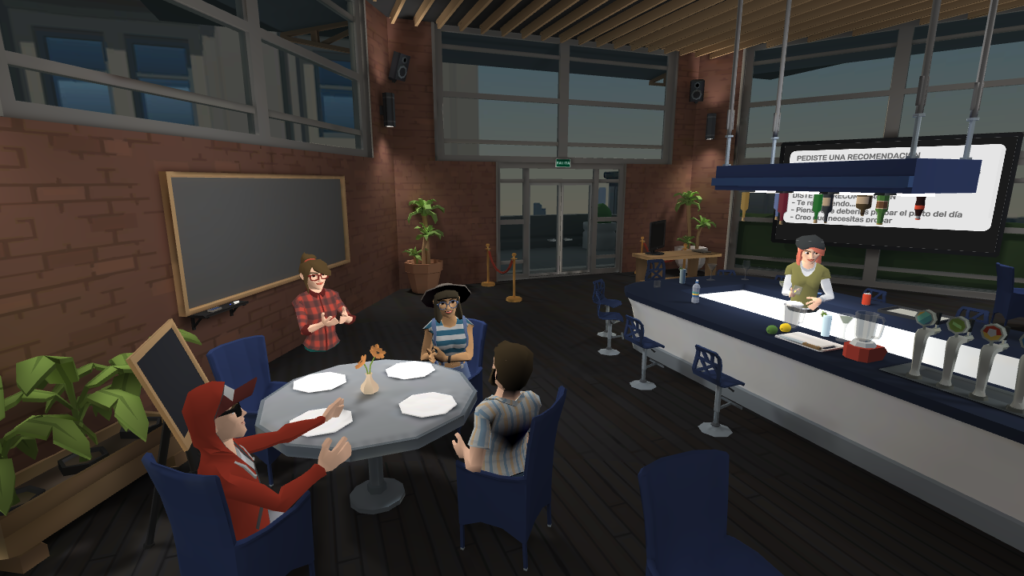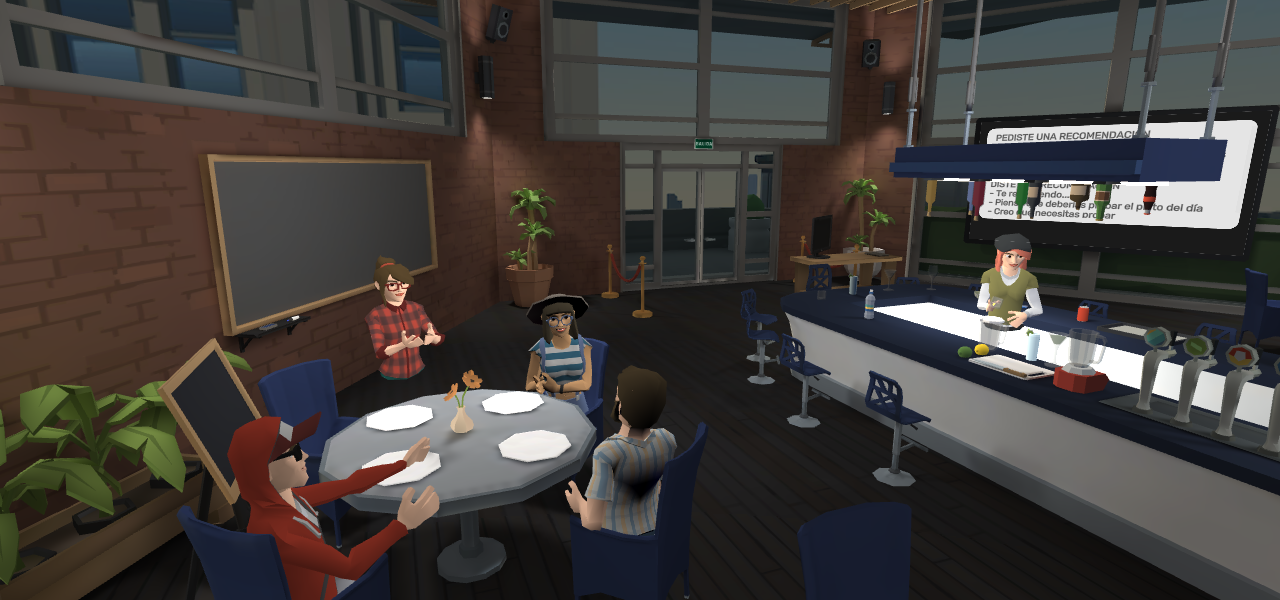Why VR?
 By Miranda Novash, Research Writer at Immerse and Adjunct Senior Instructor 1 at Portland State University
By Miranda Novash, Research Writer at Immerse and Adjunct Senior Instructor 1 at Portland State University
DOI: https://www.doi.org/10.69732/CXGF9564
Technology has brought positive changes to the language classroom. Thanks to the internet, teachers can expose students to a variety of accents and dialects, instantly find visual aids on practically any topic that comes up in class discussion, and access or even create and post authentic linguistic and cultural materials. Nevertheless, teachers are wise to be cautious consumers of very new technologies, especially those that require a significant investment of money and time.
Fully immersive VR is a case in point. On the one hand, nearly any language teacher trying it out for the first time will see what incredible potential it has for student learning. Users are completely cut off from external distractions, surrounded by a virtual environment that can convincingly simulate any setting where they might use the target language in the real world.
On the other hand, integrating immersive VR is a lot more involved than using a classroom computer or projector. For the full immersion experience, each student needs an expensive headset and training on how to use it. Getting an entire group of students into a VR app and ready to start an activity takes some time – it’s not a quick, fun activity that a teacher can do for the last ten minutes of class.
As ready-made VR apps for language learning and social interaction continue to proliferate and more educational institutions set up VR labs or purchase headsets, teachers will increasingly find themselves in a position to adopt this new technology if they so choose. Therefore, it makes sense to pause and consider the practical uses of high-immersion VR as a classroom teaching tool.
If you have never used fully immersive VR before, you might be imagining a 3D representation of a classroom where students sit at virtual desks, and the teacher writes on a digital whiteboard. In fact, this is one of the least effective ways of using this technology. Merely recreating the experience of being in a classroom does not add value to the learning experience, and in fact, a virtual classroom is less conducive to certain types of activities, such as writing, than a physical one is. The key to teaching in high-immersion virtual reality is to take advantage of the technology’s potential to help learners feel like they are not in a classroom.
To tap into the real pedagogical potential of virtual reality, we need to ask ourselves, “Why VR?” After all, traditional language classes taught by knowledgeable instructors already lead to positive learning outcomes. What can VR add that a traditional classroom lacks?
One answer is: realism. We’ve all done classroom activities, as students and as teachers, in which pairs pretend they’re in a restaurant or a doctor’s office, and they read a prepared dialogue or create their own. This provides good practice with vocabulary, grammar, pronunciation, and even pragmatics, but it cannot genuinely reproduce the experience of using the language for authentic interaction in the real world beyond the classroom. Immersive VR, on the other hand, can.
Take the example of a teacher who has instructed pairs to create dialogues for a restaurant role-play. In an ordinary classroom setting, the students would sit at their desks, each with their own unique mental image of a restaurant, trying to decide what to talk about. They would create a dialogue together, but they would not really share a restaurant experience. With high-immersion VR, on the other hand, the students can visit a virtual restaurant together, look around, and ask their server questions about the menu and the food they see (Figure 1). They will share a very realistic experience that affords them the opportunity to figure out how to negotiate authentic interactions in a real restaurant setting. Here is a full lesson plan on asking and giving advice in Spanish in a VR restaurant.

How important is this sense of realism for learning? Does it merely add a layer of fun and a novel way of doing the activity, or does it address a genuine problem? The research suggests the latter. Crucially, realism may hold the key to unlocking our brain’s ability to learn a second language through the same pathways it used for our first languages. Preliminary studies suggest that learning a language through direct interaction with objects and people in realistic virtual environments leads to the type of rich and complex vocabulary learning associated with first language acquisition. See the studies of Legault et al., 2019a and Legault et al., 2019b for fascinating reading on this subject.
If you are considering exploring the potential of this new technology to improve learning outcomes for your students, start by asking yourself these questions:
- What can high-immersion VR provide that is lacking in my classroom or teaching materials?
- How can I design a lesson or activity that draws on the special affordances of immersive VR, e.g. a sense of genuinely interacting with an environment where the second language is used?
- What potential pitfalls do I need to watch out for?
For instance, if I am teaching a unit on ordering food in a restaurant and I want to focus on question formation, there are already many resources available in my classroom: textbooks with relevant grammar charts, vocabulary, and sample sentences; a whiteboard for brainstorming or noting answers to students’ questions; a physical space for students to separate into pairs or small groups for practice. These are valuable for teaching and rehearsing the language that I want my students to be able to use. What is lacking, however, is a realistic environment where the learners can then have an authentic experience that requires them to interact the way they would in an actual restaurant. This is the gap I can fill with VR.
Virtual reality can provide a shared space with the layout and features of a restaurant, such as a cash register, booths, food items, and so on. In such a space, students encounter sights and sounds typically associated with the language they are practicing while they interact physically with the space, allowing for embodied learning. The virtual space also gives them a shared frame of reference so that they are constrained by the environment. For instance, they must order the food available at the VR restaurant and can’t just fall back on whatever familiar food vocabulary they happen to already know. This pushes the learners to negotiate meaning and learn collaboratively, such as by pointing to foods they don’t know the name of and asking others if they know the words.
I do need to think ahead about potential pitfalls, such as students merely pointing instead of learning vocabulary, becoming distracted by the interesting virtual environment, or struggling to navigate through a crowded virtual space. By anticipating these potential issues, I can plan for them, so they do not turn into problems. If the scene is so interesting that students will likely want to explore it before they can settle down to the main question formation task, I might warm up with an exploration activity such as a scavenger hunt. To avoid over-reliance on pointing, I could do vocabulary drills before entering VR to ensure students have adequate vocabulary to at least use circumlocution to communicate their ideas verbally. Before the students begin to order food, I can have them follow verbal directions to practice navigating around the space until I see they have mastered the controls.
Fully immersive VR may be the best thing to happen to language teaching this century, so long as we understand and take advantage of its affordances. As a bridge to carry students from the classroom into the real world, it may well be worth your time to explore.
There are a variety of VR apps available with realistic virtual environments where learners can interact in ways that feel authentic. Some apps, such as ImmerseMe and Mondly, are designed for independent language study, while others are designed for group interaction, like AltSpace and Immerse. The right one for you and your students will be the one that fills the gap you’ve identified while spending the least amount of time and effort learning to navigate the app. For an overview of VR apps that can be used for group excursions into VR as well as tips on using virtual reality as a teaching tool, see Teaching Languages With Virtual Reality and How Do We Immerse Our Students in Language Learning?
References:
Legault, J., Fang, S.-Y., Lan, Y.-J., & Li, P. (2019a). Structural brain changes as a function of second language vocabulary training: Effects of learning context. Brain and Cognition, 134, 90–102. https://doi.org/10.1016/j.bandc.2018.09.004
Legault, J., Zhao, J., Chi, Y.-A., Chen, W., Klippel, A., & Li, P. (2019b). Immersive Virtual Reality as an Effective Tool for Second Language Vocabulary Learning. Languages, 4(1), Article 1. https://doi.org/10.3390/languages4010013

